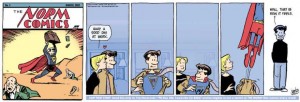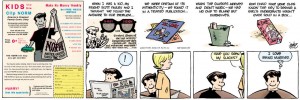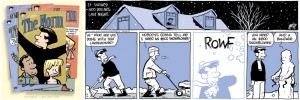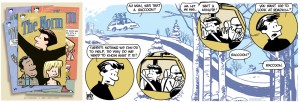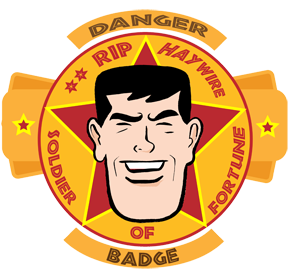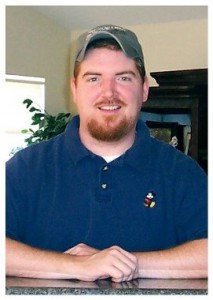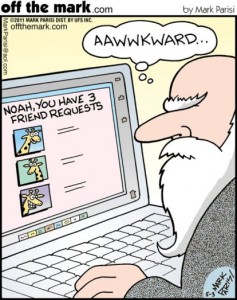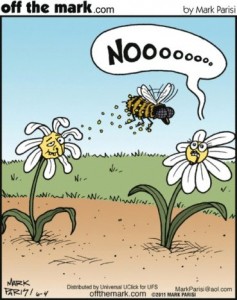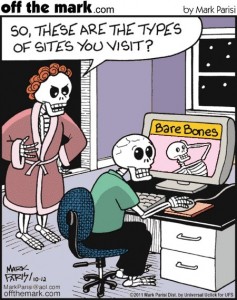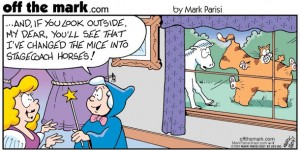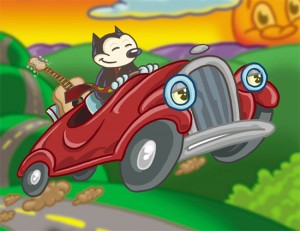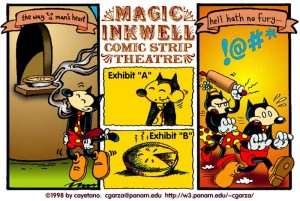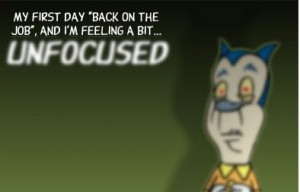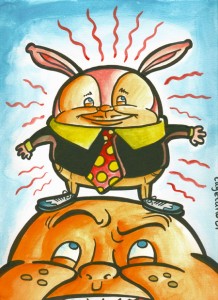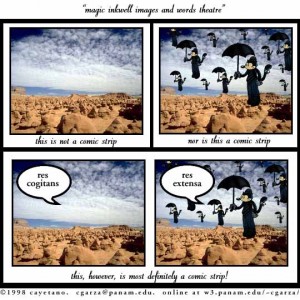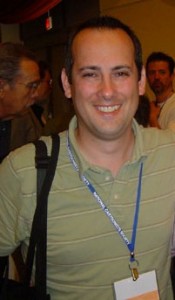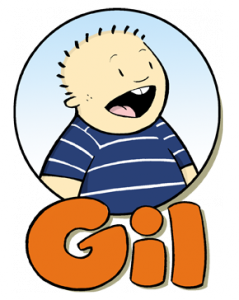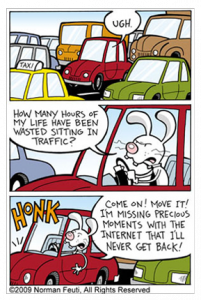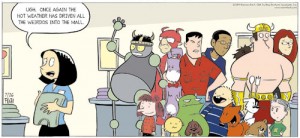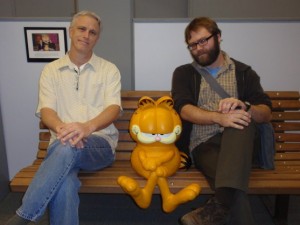
Michael Jantze (left) With SCAD Professor David Allen Duncan (and Garfield) at the Billy Ireland Cartoon Research Center at Ohio State University
Michael Jantze is an absolute amazing comic strip writer. You may know him from his comic “The Norm” and what a great and beautifully drawn piece of art. Michael now teaches as a professor at SCAD (SavannahCollegeof art and Design), owner of Jantze Studios and of course there are rumors of a new comic. Michaels work is something we all aspire to and with great pleasure I’m thrilled to feature him here at “Don’t Pick the Flowers”.
David: Michael you have quite an amazing career, and a very busy one. The first place to start would be your comic “The Norm”. Visually it’s amazing and the story telling is great. Initially when did you decide to become a cartoonist and where did the whole idea for “The Norm” come from?
Michael: I got serious about syndication sometime in the late 1980s. I was studying for the GRE to return to college for a masters and spent most of my evenings either studying or avoiding studying. The product of the avoidance was doodling some new strips with the characters from my college comic strip “NormalState”. When the pile of strips hit 30 or so, I decided I’d try to submit to syndication…but first I decided I wanted to draw at least 100 to make sure I could do it “forever”. When I got to about 100 I decided to self-publish a book, so I renamed the strip “Normalu.s.a.” and printed a limited edition of 1000. Somewhere on that timeline I quit studying for the GRE and started Harvest Moon Publications. I printed the one book, sent out some samples to syndicates, got interest from United Media and King Features and a contract from DC Comics. So that’s where that all started. “Normalu.s.a.” eventually got a development deal from United Media in, I think, 1991. By then I was under contract with DC for an original 180-page graphic novel. By 1993, my development deal was over and I was negotiating with DC to stop work on the book and regain my copyright.
So “The Norm” started as a daily journal. I was frustrated with the way editors were trying to push me away from my strengths. I decided I would draw a strip a day in a journal about my life…my thoughts…whatever…the conceit of Norm talking to the reader grew out of that exercise and Woody Allen’s film “Annie Hall”. By this time I was working as a journalist and needed a way to talk about the ordinary things in life instead of all the crime, corruption and garbage I was seeing. I needed a way to make sure I didn’t become just another misanthropic reporter.
I wanted it to be like stand-up comedy on paper.
David: “The Norm” was syndicated by King Features (and pulled by you), and now is on “gocomics”. Do you miss doing it? I’ve heard you may start another comic, or is that half way top secret?
I miss Norm. He’s fun to draw and a riot to write for. I think if I wrote new stories they’d need to be graphic novels or animated features. I think Norm grew out of the gag-a-day format but the concept of being normal is still very alive. I think probably more so in this economic poop-fest than during the bubbles of the past 15 years. I have worked on two new ideas…one about 8 years ago titled “Ages 2 and Up”…but Richard Thompson’s “Cul de Sac” showed up and was the prettier sister of my idea. I really enjoy the way he handled the same topic I wanted to approach, so I moved on to another idea. The current comic I’m writing is titled “Family Theater” and it’s about us four Jantzes…a little simpler concept but a lot of fun to draw when I have time. I have no idea when it’ll be ready. I keep not working on it.
David: You are the owner of Jantze Studios; can you give a little insight into your company and what your company does?
Michael: I set up an animation studio in 2007 to contribute to an art form that was being abandoned by the animation corporations: hand-drawn animation. Our first work was for corporate clients like Blackstone Real Estate, Hilton Hotels, YouTube and some other dot-com companies. We created characters to help tell brand stories. I think the most successful of those is Mr. Lux (the short is on my jantzestudios page on YouTube).
Then I got a call from some cartoonists wondering what I was up to, so we worked on some cartoon brands to help them figure out cost-effective content solutions to new media platforms. The outcome of that was something I call Audio Comics…like an audio book. We created 30 motion comics for “Zits” as well as some low-cost animations for “Cul de Sac”, “Baby Blues” and others.
David: You are also a professor at SCAD in Savannah Georgia, what’s it like for a student to be in your class? What are some of the things you teach?
Michael: I have no idea what it’s like for them, to be honest. They probably go home and either try to figure out how to get their money back or cry. Just kidding, of course. I hope my students see my passion for storytelling across all mediums. I work diligently to make the theory lessons of each class relevant to the practical applications in the current job market. We talk a lot about how each of the assignments and projects will apply to “real life” when their working for a company or themselves.
I teach in both the Sequential Arts department and Animation. My animation classes are on digicell pipeline production…that’s hand-drawn animation paired with Adobe or ToonBoom software for production tools.
I also teach the history of comic art, comic book writing, webcomics, new media comics, character design and storyboarding for animation as well as a host of other classes.
And I’m using SCAD students and graduates for current projects, to help them get the experience they need to land on both feet and be relevant in this contracting job market.
I’m teaching my first online class this quarter and it’s been fun working with student from all over theU.S.and even one fromHong Kong. SCAD has amazingly talented students and it’s my job and honor to hook them up to the “creative cart”.
David: There are different styles of comics, but in your opinion what makes a great comic?
Clarity. Period. Everything else is debatable.
David: What advice do you give to anyone who wants to become a cartoonist?
Michael: Go for it! But I’d suggest getting some small business classes and computer/software experience to work in this new media market. I tell my students who want to be freelancers that the Graphic Artist Guild’s Pricing and Ethical Guidelines book is your father and the Writers & Graphic Designers Market book is your mother. One helps you with contracts and billing, the other sets up your play dates with editors and publishers. If you desire to work for a company, you better be a genius at computers and 2D and 3D programs…and you’re best bet for an entry job is in gaming or app development…huge growth for artists and writers right now. Remember, all roads lead to the bigger companies.
David: Thank you Michael for taking the time to be featured at “Don’t Pick the Flowers”. Thank you for sharing insights into your world and your work is fantastic all the way around. I’m in absolute awe!
For more of Michael Jantze, check out these links!
Michael Jantze Studio: jantze.com
Facebook: www.facebook.com/jantzestudios
Twitter: twitter.com/#!/michaeljantze
Animation: www.youtube.com/jantzestudios

